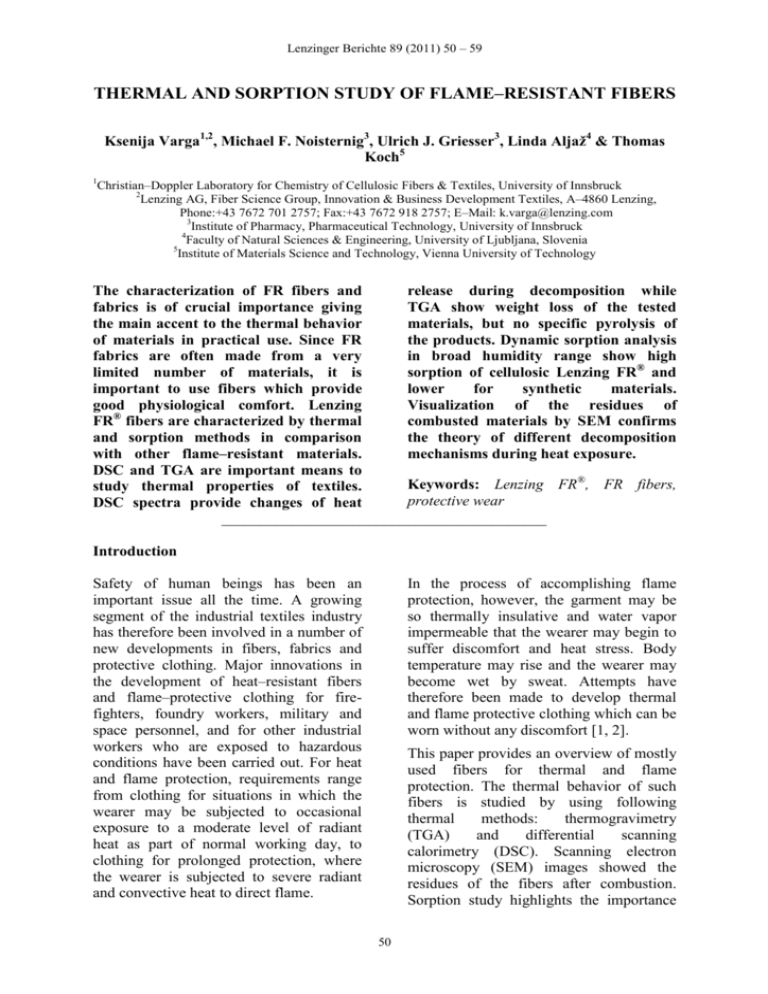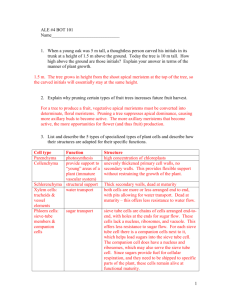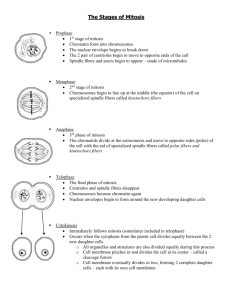THERMAL AND SORPTION STUDY OF FLAME–RESISTANT FIBERS
advertisement

Lenzinger Berichte 89 (2011) 50 – 59 THERMAL AND SORPTION STUDY OF FLAME–RESISTANT FIBERS Ksenija Varga1,2, Michael F. Noisternig3, Ulrich J. Griesser3, Linda Aljaž4 & Thomas Koch5 1 Christian–Doppler Laboratory for Chemistry of Cellulosic Fibers & Textiles, University of Innsbruck 2 Lenzing AG, Fiber Science Group, Innovation & Business Development Textiles, A–4860 Lenzing, Phone:+43 7672 701 2757; Fax:+43 7672 918 2757; E–Mail: k.varga@lenzing.com 3 Institute of Pharmacy, Pharmaceutical Technology, University of Innsbruck 4 Faculty of Natural Sciences & Engineering, University of Ljubljana, Slovenia 5 Institute of Materials Science and Technology, Vienna University of Technology The characterization of FR fibers and release during decomposition while fabrics is of crucial importance giving TGA show weight loss of the tested the main accent to the thermal behavior materials, but no specific pyrolysis of of materials in practical use. Since FR the products. Dynamic sorption analysis fabrics are often made from a very in broad humidity range show high limited number of materials, it is sorption of cellulosic Lenzing FR® and important to use fibers which provide lower for synthetic materials. good physiological comfort. Lenzing Visualization of the residues of FR® fibers are characterized by thermal combusted materials by SEM confirms and sorption methods in comparison the theory of different decomposition with other flame–resistant materials. mechanisms during heat exposure. DSC and TGA are important means to Keywords: Lenzing FR®, FR fibers, study thermal properties of textiles. protective wear DSC spectra provide changes of heat __________________________________________ Introduction Safety of human beings has been an important issue all the time. A growing segment of the industrial textiles industry has therefore been involved in a number of new developments in fibers, fabrics and protective clothing. Major innovations in the development of heat–resistant fibers and flame–protective clothing for firefighters, foundry workers, military and space personnel, and for other industrial workers who are exposed to hazardous conditions have been carried out. For heat and flame protection, requirements range from clothing for situations in which the wearer may be subjected to occasional exposure to a moderate level of radiant heat as part of normal working day, to clothing for prolonged protection, where the wearer is subjected to severe radiant and convective heat to direct flame. In the process of accomplishing flame protection, however, the garment may be so thermally insulative and water vapor impermeable that the wearer may begin to suffer discomfort and heat stress. Body temperature may rise and the wearer may become wet by sweat. Attempts have therefore been made to develop thermal and flame protective clothing which can be worn without any discomfort [1, 2]. This paper provides an overview of mostly used fibers for thermal and flame protection. The thermal behavior of such fibers is studied by using following thermal methods: thermogravimetry (TGA) and differential scanning calorimetry (DSC). Scanning electron microscopy (SEM) images showed the residues of the fibers after combustion. Sorption study highlights the importance 50 Lenzinger Berichte 89 (2011) 50 – 59 of using cellulosic flame–retardant fibers in the protective fiber blends. expected to support the wearer’s work; they should not shrink or melt, and if then decompose, from char. These requirements cannot be met by thermoplastic fibers and so resource must be made from aramid fibers, flame–resistant cellulosics or wool. It may also be noted that the aramid fibers with their high limited oxygen index (LOI) and high thermal stability, have not been found suitable for preventing skin burns in molten metal splashes because of their high thermal conductivity. The mode of decomposition and the nature of the decomposition products (solid, liquid and gaseous) depend on the chemical nature of the fiber, and also on the type of applied finishes or coatings. If the decomposition products are flammable, the atmospheric oxygen raises ignition, with or without flame. When the heat evolved is higher then that required for thermal decomposition, it can spread the ignition to the total material destruction. In addition to the fiber characteristics and fabric finish, several garment characteristics also influence the thermal protection. For a given fabric thickness, the lower the density, the greater is the thermal resistance. This applies on char– forming fibers such cellulosics and wool. Hence, thicker fabric made from cellulosics or wool or other non–melting fibers give good thermal protection, whereas the thicker thermoplastic fibers– fabric produce burns. Thermal properties of some fibers are given in Table 1 [1]. Concerning environmental point of view, Horrocks et al. developed an analytical model for understanding the environmental consequences of using flame–retardant textiles. An environmental rank value is given at each stage in the manufacturing process and product life of each flame– retardant fibers and fabrics. The results show that each of the eleven generic fibers analyzed showed an environmental index value within the range of 32–51% where 100 denotes the worst environmental position possible [3]. Thermal behavior of fibers The effect of heat on textile materials can produce physical and chemical changes. The physical changes occur at the glass transition (Tg ) , and melting temperature (Tm ) in thermoplastic fibers. The chemical changes take place at pyrolysis temperature (T p ) at where thermal degradation occurs. The combustion is a complex process that involves heating, decomposition leading to gasification (fuel generation), ignition and flame propagation. A self–sustaining flame requires a fuel source and a means of gasifying the fuel, after which it must be mixed with oxygen and heat. When a fiber is subjected to heat, it pyrolyses at Tp and volatile liquids and gases, which are combustible, act as fuels for further combustion. After pyrolysis, if the temperature is equal or greater than combustion temperature Tc , flammable volatile liquids burn in the presence of oxygen to give products such as carbon dioxide and water. When a textile is ignited heat from an external source raises its temperature until it degrades. The rate of this initial rise in temperature depends on: the specific heat of the fiber, its thermal conductivity and also the latent heat of fusion (for melting fibers) and the heat of pyrolysis. In protective clothing, it is desirable to have a low propensity for ignition from a flaming source or, if the item ignites, a slow fire spread with low heat output would be ideal. In general, thermoplastic fibers such as polyamide or polyester fulfill these requirements because they shrink from the flame. If they burn, they burn with a small and slowly spreading flame and ablate. For protective clothing, however, there are additional requirements, such as protection against heat by providing an insulation, as well as high dimensional stability of fabrics. Upon heat exposure, they are 51 Lenzinger Berichte 89 (2011) 50 – 59 Table 1. Thermal and flame–retardant properties of some fibres [1]. Fibre Tg [ C ] Tm [ C ] Tp [ C ] Tc [ C ] LOI Glass Melt Pyrolysis Combustion [% ] transition Viscose (CV) - - 350 420 18.9 Cotton (CO) - - 350 350 18.4 Wool (WO) - - 245 600 25 Polyester (PES) 80-90 255 420 –477 480 20–21.5 Acrylic (PAN) 100 >320 290 >250 18.2 Modacrylic (MAC) <80 >240 273 690 29–30 Meta–aramid (AR) 275 375 310 500 28.5–30 Para–aramid (AR) 340 560 590 >550 29 co-monomers during co–polymerization, introduction of an FR additive during extrusion and application of flame retardant finishes or coating. Additives and co–monomers are halogen or phosphorus– based [1]. Materials for flame protection Flame Resistance Cellulosics Inherently flame–resistant viscose fibers are produced by incorporating FR additives (fillers) in the spinning dope before extrusion. For example: phosphorous additives, polysilicic acid or polysilicic acid and aluminum [1]. Flame-retardant Acrylic Like other synthetic fibers, acrylic fibers shrink when heated, which can decrease the possibility of accidental ignition. However, once ignited, they burn vigorously accompanied by black smoke. Halogen–based and particularly bromine derivatives or halogen– or phosphorus– containing co–monomers, are the most effective flame retardants used in acrylic fibers. A number of spinning dope additives are also known to render acrylic fibers flame retardant, for example esters or antimony, tin and their oxides, SiO2, halogenated paraffins, halogenated aromatic compounds and phosphorus compounds [1]. Lenzing AG currently produces Lenzing FR® which contains phosphorus / sulfur– containing additives [4]. Rüf et al. patented a new procedure for producing TENCEL® fibers with reduced flammability. The invention relates to a cellulosic molded body containing a cellulose / clay nanocomposite. The clay component of said nanocomposite comprises a material selected from the group consisting of unmodified hectorite clays and hydrophilically modified hectorite clays [5]. There are also viscose fibers with incorporated polysilicic acid available on the market [1]. Aramids Aromatic polyamides char above 400 °C and can be exposed to temperatures up to 700 °C. Meta–aramid fibers have been developed for protective clothing for fighter pilots, tank crews, and astronauts. Flame-retardant Polyester There are three methods of rendering synthetic fibers flame retardant: use of FR 52 Lenzinger Berichte 89 (2011) 50 – 59 The meta–aramid nonwovens are also used for hot gas filtration and thermal insulation. Para–aramid fibers are used for ballistic and flame protection. Generally, meta–aramides are used in heat protective clothing. However, para–aramid fibers are added to improve the mechanical stability [1]. Meta–aramid fibers are blended with Lenzing FR® and FR–treated wool. study the energy and mass changes of various FR fibers during temperature increase. The use of these FR fibers in clothing requires sufficient physiological comfort. Therefore, FR fibers have to provide good sorption properties. Additionally to the thermal study, moisture sorption isotherms and WRV (water retention value) measurements were done on FR samples to have a notion about the physiological behavior of FR fibers in use. By SEM, the visualization of fiber residue after burning was conducted. Polyimide Another aromatic copolyamide fiber is polyimide (brand name P84®; produced by Evonik Industries). The fiber does not melt but becomes carbonized at 500 °C with LOI value 36–38%. The application of high–performance P84® fibers include protective clothing, as a sealing or packing material, for hot gas filtration and in aviation and space including aircraft seats [1]. Experimental Materials In this work, thermal behavior of Lenzing FR® fibers was compared with flame– retardant polymers. The characteristics of used samples are given in Table 2. Phenolics Melamine polymer is obtained by condensation reaction between melamine and formaldehyde. The cross–linked polymer is then spun to melamine fibers. They can be used in continuous service at 200 °C. Above 370 °C, thermal degradation result in char formation rather then molten drip [1]. Table 2. Fibres used for thermal and sorption study. Lenzing Modal® 1.3 / 38 Modacrylic FR modacrylic fiber is a copolymer of acrylonitrile, vinyl–chloride or vinyliden– chloride in ratio of 60:40 wt% along with a sulphonated vinyl monomer [1]. TENCEL® 1.3 / 38 Meta–aramid 1.7 / 50 Para–aramid Fabric Modacrylic 2.8 / 38 Aim of our work DSC and TGA are important means to study thermal properties of textile materials, fabrics and fibers. However, DSC spectra provide changes of temperature of the material in pyrolysis and the changes of heat release, but no other thermal properties. TGA can show weight losses of fibers and fabrics under different temperature, but not the concrete pyrolysis processes and products. In this study, DSC and TGA were employed to Polyimide 2.2 / 53 Melamine 2.2 / 90 Flame–retardant 7.0 / 60 Fibre Type Characteristics Titer [dtex] / Length [mm] Lenzing FR ® 2.2 / 51 polyester Methods Thermal analysis Thermogravimetric Analysis (TGA) Approximately 20 mg of compressed fibers rolled in a small ball were placed in 53 Lenzinger Berichte 89 (2011) 50 – 59 the sample pan. The temperature programme was set from 23 °C until 600 °C with a heating rate 10 Kmin-1. All measurements were done under air atmosphere to get more realistic results since oxygen is needed to burn the fibers. Before measurements all fibers were carded to ensure maximum homogeneity of the fibers and better reproducibility of the results. A TA instruments TGA 2050 was used. TIIL–PRÜFANWEISUNG 092/00. The fiber sample (0.35 g) was weighed in the centrifuge glass and wetted for 10 minutes in deionized water (15 mL). After that, the sample was centrifuged for 15 minutes at 3000 rpm and weighed immediately (mw). Then the samples were dried for 24 h at 105 °C and weighed again (md). The WRV was calculated according to Equation (1). The value expresses the water amount held in the pores inside the fibers. WRV % Differential Scanning Calorimetry (DSC) 10–12 mg of fibers were compressed and placed in the sample pan. Four holes were made in the sample lid to allow the off– gases to escape. Heating rate was set at 10 Kmin-1. For these experiments, standard pan and standard lids were used (pan 900786.901; lid 900779.901). Preparation of samples for DSC is more sensitive than for TGA and more attention had to be paid to the sample preparation. Two parallel measurements were done and the average value was calculated. An untreated sample was also measured in parallel in order to investigate the effect of the incorporated polymers on the temperature stability. mw md 100 md (Eq. 1) Visualization of burned fibers Lenzing FR®, modacrylic, FR polyester and meta–aramid fibers were burned and viewed under SEM. The samples were Au–coated for 60 s. A Hitachi S–400 SEM was used with a relatively low accelerating voltage of 5 kV to prevent beam damage of the samples. Results and discussion Thermal analysis Mass change by TGA TGA is a basic method for characterization of flame–retardant materials under high– temperature environments. By the first derivation of the mass change curve it is possible to determine the temperature at which the degradation rate is the highest (the peak of the first derivation). In this work this temperature is defined as degradation point [7]. The TGA plots of examinated fibers are shown in Figure 1, Figure 2 and Figure 3. Plots of standard and modified cellulosics are summarized in Figure 1. There are no differences in degradation point between TENCEL® and Lenzing Modal® (305 °C). At 450 °C the whole cellulose is burned. Very good results in heat protection show Lenzing FR® fibers. The thermal decomposition of Lenzing FR® fibers occurs in two steps: the first point is at 250 °C (most of the FR–agent reacts) and the second degradation point is 458 °C. At the Sorption study Dynamic Sorption Analysis Moisture sorption measurements were done on dynamic sorption analyzer (SPS 11 Analyser, Projekt–Messtechnik, D– Ulm). The measurements of the fiber samples by dynamic sorption analyzer were described in detail by Okubayashi et al. [6]. In brief, the atmosphere in the analyzer was conditioned at 25 °C and 0 % relative humidity (RH) until equilibrium was achieved. Then, the moisture cycle was started increasing the RH in 10 % RH steps (interval method). The maximal achieved RH was 90 % for measurements at 25 °C. Water Retention Value The WRV value denotes the amount of water held inside the fiber after wetting and centrifuging. The measurements were performed following a Lenzing protocol 54 Lenzinger Berichte 89 (2011) 50 – 59 temperature 250 °C to 700 °C, the material degrades slowly with a residue of 8% (w/w) at 700 °C. ® Lenzing FR ® TENCEL ® Lenzing Modal 100 80 Relative Mass [%] the garment fabric helping to eliminate air movement and heat transfer to the interior skin area. As both the fiber and the fabric thicken together this increases the insulating barrier and therefore reduces heat transfer to the wearer. Polyimide (brand name P84®) is more stable then meta–aramid and FR polyester. It degrades at 510 °C. Degradation ® Lenzing FR = 250 °C ® TENCEL = 305 °C ® Lenzing Modal = 305 °C 60 40 20 Para-aramid Meta-aramid Polyimide FR polyester 100 AIR 100 200 300 400 500 600 Relative Mass [%] 0 700 Temperature [°C] Figure 1. TGA graph of cellulosics. Phosphorous containing FR agents incorporated in Lenzing FR® fibers work according to following principle: during burning, a protective layer is formed on the surface of fabric by the production of polyphosphoric acid and carbonization, e.g. by release of water. These P– containing FR agents have to decompose before the cellulose decomposes. If the decomposition of cellulose occurs at 305 °C (derived from TGA curves), then the P– agents have to decompose below this temperature to form a protective layer [8]. In Figure 2 the traces of synthetic polymers show significantly higher degradation points then measured for cellulosics. The role of high–performance polymers is not to react before the basic material (like in the case of cellulose), then to postpone the melting point to higher temperatures. The heat energy is spent on melting of polymer or on radical reaction like in FR polyester. The tested samples degrade at two major points: 431 °C and 517 °C which indicate that various modifications are present in the polymer. Para–aramid degrades at 521 °C. Meta–aramid, due to the meta–position of aromatic rings is less stable then para– aramid. Meta–aramid degrades at 476 °C. The physical action of the meta–aramid fiber when exposed to a heat source is that the fiber itself absorbs heat energy during the carbonization process. The fiber swells and thickens in size and seals openings in 80 60 40 20 Degradation Para-aramid=521 °C Meta-aramid=476 °C Polyimide=510 °C FR polyester=431 °C/517 °C AIR 0 100 200 300 400 500 600 700 Temperature [°C] Figure 2. TGA plots of synthetic FR fibers. TGA plots of other high–performance synthetic fibers melamine and modacrylic are shown in Fig. 3. Both, melamine and modacrylic fibers degrade in two major steps. Modacrylic is less stable then melamine. Modacrylic degrades at 236 °C (first point) and 503 °C (second point). The two–step degradation of this polymer is explained by the formation of acrylic and modacrylic (halogen containing) components in a ratio approx. 60:40 wt%. Halogens contained in modacrylic work on the principle of radical reaction. The acrylonitrile component works on the principle of char formation. Melamine also degrades in two steps: 363 °C and 617 °C. The thermal degradation in melamine results in char formation rather then molten drip. 55 Lenzinger Berichte 89 (2011) 50 – 59 0 -2 Melamine Modacrylic 80 -1 Heat Flow [Wg ] Relative Mass [%] 100 60 40 20 Degradation Melamine=363 °C / 617 °C Modacrylic=236 °C / 503 °C -4 -6 -14 -16 -18 -20 AIR 0 100 200 300 400 500 600 Para-aramid Meta-aramid Polyimid -8 -10 -12 Endo Up 100 700 200 Temperature [OC] 0 -1 Endo Up 300 600 -2 Heat Flow [Wg ] -1 Heat Flow [Wg ] ® Lenzing FR ® TENCEL ® Lenzing Modal 200 500 The DSC traces of melamine and modacrylic show first smaller peaks (where char is formed) and the reaction is finished (Figure 6). The second part of the thermal degradation is melting. Like in other high–performance fibers, the melting of melamine occurs at the beginning of the reaction. Energy changes by DSC The heat released or absorbed during the thermal conversion is measured by DSC. 100 400 Figure 5. DSC Plots of synthetic FR fibers. Figure 3. TGA plots of melamine and modacrylic fibers. 2 0 -2 -4 -6 -8 -10 -12 -14 -16 -18 -20 300 Temperature [°C] 400 500 600 Temperature [°C] Figure 4. DSC Plots of cellulosics. -4 -6 -10 -12 -14 In Figure 4, DSC traces of cellulosics are shown. At the beginning of the measurement, there is a small endothermic peak due to the water evaporation. Both standard and Lenzing FR® show exothermic peaks while those for Lenzing FR® are significantly smaller and narrower due to the phosphorous/sulfur based agents. DSC plots of high–temperature polymers are shown in Figure 5. Exothermic peaks are not measured at these samples, which indicate, that the exothermic reaction which started at 350 °C is still ongoing at 600 °C. Melamin Modacrylic -8 Endo Up -16 100 200 300 400 500 600 O Temperature [ C] Figure 6. DSC modacrylic fibers. plots of melamine and If we compare TGA and DSC data, the correlation of the degradation points of the temperatures show exact fitting. The combination of these two analytical methods provides a very useful tool in fiber characterization and product development. Sorption study Water vapor sorption Dynamic sorption analysis is a very precise method for material characterization. It covers the whole range 56 Lenzinger Berichte 89 (2011) 50 – 59 of relative humidities, where the 50–70 % RH range is relevant for physiological comfort. So, the comparison of the materials in this paper focuses on this humidity range. All isotherms show sigmoid–shaped curves, which are typical for hygroscopic materials. In Figure 7, TENCEL® and Lenzing Modal® show the highest sorption (9 – 13 %) where the sorption capacity of Lenzing FR® is slightly lower due to the incorporated additives (7 – 11%). The isotherms of synthetic fibers are rather linear (Figure 8). In the humidity range 50 – 70 %, meta– aramid and melamine absorb 5 – 6% H2O. Para–aramid and polyimide absorb 2 – 3 % and the lowest sorption is measured for modacrylic – only 0.5 to 1%. 25 Table 3. WRV cellulosics. of Fiber Lenzing FR® TENCEL® Lenzing Modal® standard and modified WRV [%] 48.6 ± 0.16 67.1 ± 0.51 57.6 ± 0.95 Table 4. WRV of synthetic FR fibers. ® Fiber Para–aramid Meta–aramid Polyimide Melamine Modacrylic Lenzing FR ® Lenzing Modal ® TENCEL 20 Moisture Sorption [%] the materials (Table 3 and Table 4). As TENCEL® is more porous then Lenzing Modal®, the WRV is higher. The values decrease slightly with incorporation of FR particles. Like in vapor sorption, WRV values for synthetics are significantly lower. The sorption is in this case higher for melamine and meta–aramid fibers. 15 WRV [%] 5.9 ± 0.19 12.1 ± 0.80 5.6 ± 0.26 11.8 ± 0.23 7.3 ± 0.17 10 5 0 0 10 20 30 40 50 60 70 80 90 100 RH [%] Visualization of burned fibers Figure 7. Sorption isotherms of cellulosics. Moisture Sorption [%] 25 SEM images of burned fibers support the theory about the decomposition mechanism of various FR fibers. In Figure 9 images of five mainly used protective fibers are shown. Lenzing FR® keeps shape after burning. A carbon–layer is formed on the surface and prevents the fibers from further burning. Modacrylic fibers shrink in the contact with flame and tear afterwards. FR polyester melts during heat exposure, which is not an ideal option since molten fibers can stick to the skin and skin burns are possible. Meta–aramid fibers expand during the thermal treatment, (volume increase) and form a protective barrier which prevents from further burning of the fiber. Para-aramid Meta-aramid Polyimide Melamine Modacrylic 20 15 10 5 0 0 10 20 30 40 50 60 70 80 From this results it can be concluded, that the application of hygroscopic FR fibers in protective clothing is crucial to provide good wear comfort of protective textiles. 90 100 RH [%] Figure 8. Sorption isotherms of synthetic FR fibres. Water retention values (WRV) Parallel to the vapor sorption, sorption of liquid water is measured for textile materials which refers to the porosity of 57 Lenzinger Berichte 89 (2011) 50 – 59 Figure 9. SEM images of FR fibers before and after burning. Lenzing FR® before burning after burning 10 µm Modacrylic before burning 10 µm after burning 20 µm FR polyester before burning 70 µm after burning 300 µm 20 µm Meta–aramid before burning after burning 30 µm 20 µm 58 Lenzinger Berichte 89 (2011) 50 – 59 [3] Horrocks A. R., Hall M. E. & Roberts D: Environmental consequences of using flame–retardant textiles – a simple life cycle analytical model, Fire and Materials 21 (1997), pp. 229–234. Conclusions and outlook In this work, Lenzing FR® fibers were characterized by different analytical methods and their behavior in practical use has been investigated in comparison to other protective fibers. Thermal methods – DSC and TGA are precise tools for observing thermal degradation – mass / energy changes with increasing temperature. The results of both thermal methods showed good correlation. Improved physiological performance of protective clothing is important and the standards for protective clothing require materials with improved comfort properties. Therefore, new developments in this segment are crucial to be at the state of the art with the market trends. The disadvantage of using synthetic fibers is associated with poor wear comfort. The emphasis is placed on the use of Lenzing FR® in workwear as best solution between functionality and comfort. This statement is supported by the sorption isotherms showing high absorbency for cellulosics and low absorbency for synthetics. In the field of cellulosic materials, newest developments have been focused on spun– dyed Lenzing FR®, especially in high– visibility colors for protective wear. [4] http://www.lenzing.com/fasern/lenzingfr.html [5] Rüf H., Firgo H. & Kroner G.: Cellulosic Molded Body, Method for Manufacturing it and Use Thereof, US 2008/0233821 A1, 2008. [6] Okubyashi S., Griesser U.J. & Bechtold T.: A kinetic study of moisture sorption and desorption on lyocell fibres, Carbohydrate Polymers 58 (2004), pp. 293–299. [7] Aljaz L., Varga K. & Koch T.: DSC & TGA Analysis of Lenzing FR® Fibres, 41th International Symposium on Novelties in Textiles, 27–29 May 2010, Ljubljana, Slovenia. [8] Einsele U.: Über Wirkungsweise und synergistische Effekte bei Flammschutzmittel für Chemiefasern, Lenzinger Berichte 40 (1976), pp. 102– 116. Acknowledgements Authors gratefully acknowledge to Ms. Sandra Schlader for SEM images and to Ms. Agnes Uwaleke for WRV data. References [1] Bajaj P.: Heat and Flame Protection, in Handbook of Technical Textiles (Ed. Horrocks R. A. & Anand, S.C.), Woodhead Publishing Limited (2000), ISBN 1 85573 385 4. [2] Hull T. R. & Kandola B. K. (Ed.): Fire Retardancy of Polymers – New Strategies & Mechanisms, © Royal Society of Chemistry 2009, ISBN 978–0–85404–149–7. 59







